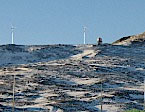Rethinking Polar Power
Later this month, Meridian Energy will begin work on the most southernmost wind farm in the world, on Crater Hill, Ross Island in Antarctica. The turbines will provide renewable energy to New Zealand’s Scott Base and to the American base at McMurdo Station. Three German-built turbines, each on a 128-foot tower and each generating 300 kilowatts, will be erected on a ridge line at Scott Base. With few alternatives in the harsh conditions, “diesel is still very much the lifeblood of the Antarctic,” said acting division director for Antarctic infrastructure and logistics at the National Science Foundation’s Office of Polar Programs Brian W. Stone. But renewable energy is trimming the size of the problem. The project will cut consumption by approximately 463,000 litres of fuel every year between the two bases – initially reducing fuel consumption by 11 per cent. The project will also result in a reduction of greenhouse gas production from both bases of 1,242 tonnes of CO² annually Work will be carried out over two summer periods with the turbines planned to be up and running by the end of February 2010.















